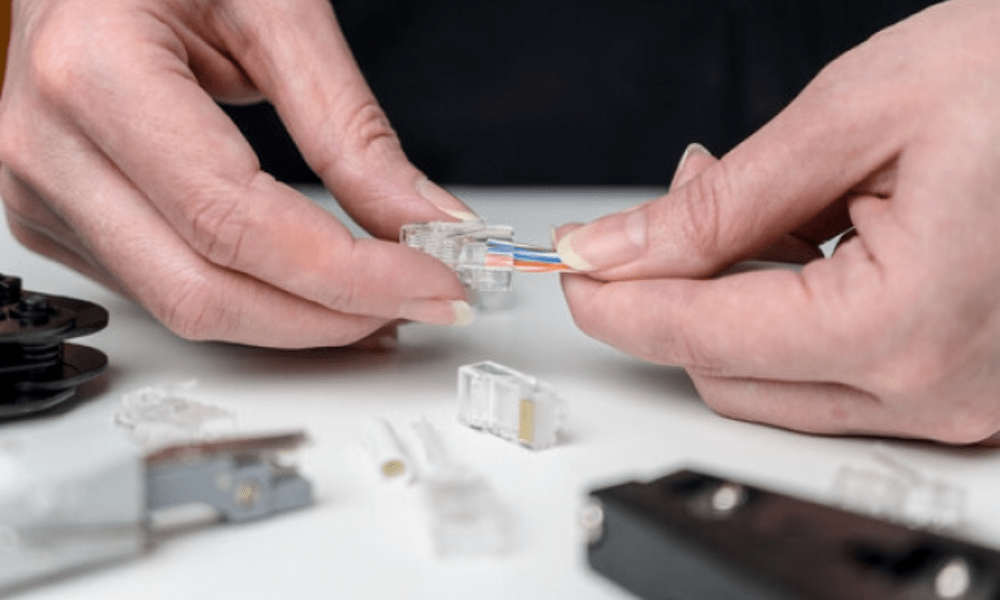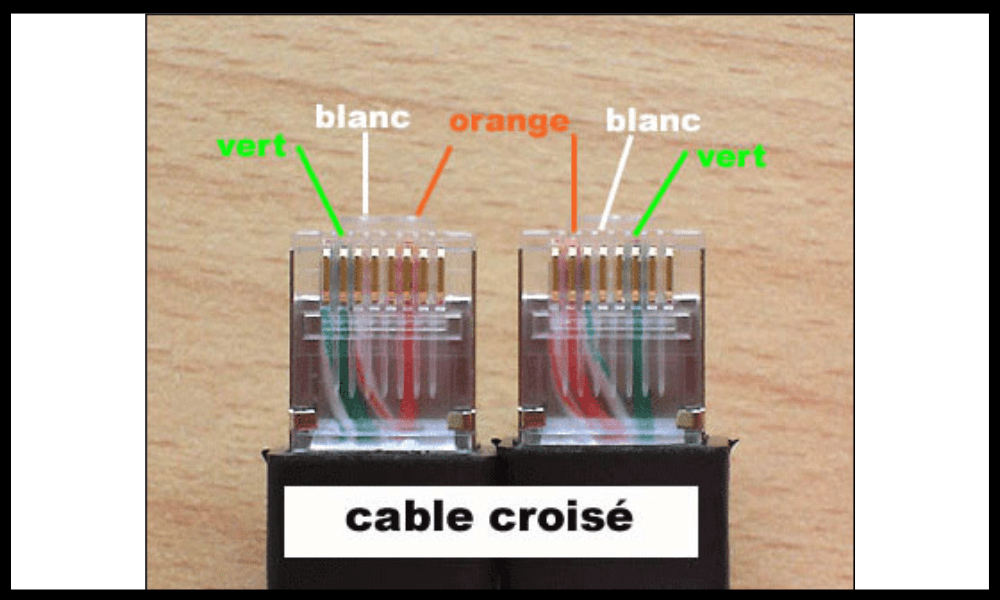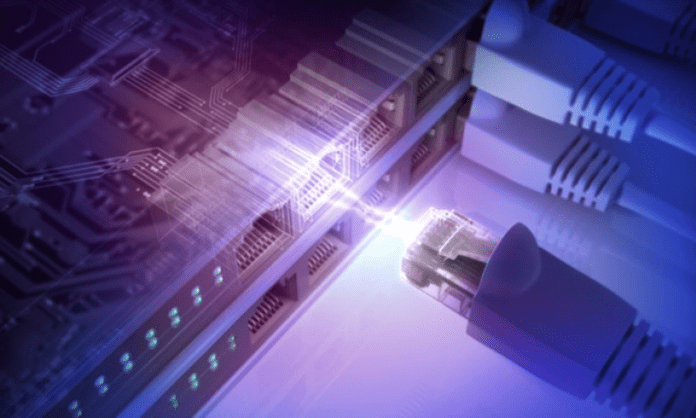An RJ45 jack is a jack used to connect computing devices to a local network . It allows high-speed data transmission via an Ethernet cable. Wiring an RJ45 jack is not very complicated , but it does require a few tools and a little patience.
In this article, we will explain how to wire an RJ45 jack step by step .
What tools are needed to wire an RJ45 socket?
To wire an RJ45 jack, you will need the following tools:
- An Ethernet cable of the desired length
- Crimping pliers
- A knife or cutter
- A stripping pliers
- A female RJ45 socket
- A male RJ45 socket
Wiring an RJ45 socket: the different steps
Prepare the Ethernet cable

The Ethernet cable is made up of eight wires of different colors, grouped into four twisted pairs. Each pair corresponds to a color code:
- Pair 1: white-orange / orange
- Pair 2: white-green / green
- Pair 3: white-blue / blue
- Pair 4: white-brown / brown
The RJ45 color code is a convention that defines the order of the wires in the jack, depending on whether the T568A or T568B . It is important to respect the RJ45 color code to ensure correct data transmission.
The first step is to cut the Ethernet cable to the desired length, leaving a few centimeters of margin. Next, you need to strip the cable about 3 cm at each end, being careful not to damage the wires . You then need to separate the threads and untangle them.
Respect the color code of the RJ45 cabling
There are two RJ45 cabling standards: T568A and T568B . They differ in the order of the wires in the socket. You must choose one standard or the other and stick to it for both ends of the cable. Here is the diagram of the two standards:

It is therefore necessary to align the wires according to the chosen color code, respecting the reading direction from left to right. You must then cut the wires flush with the cable sheath , ensuring that they are all the same length.
Insert the wires into the RJ45 jack
You must then insert the wires into the RJ45 socket , respecting the order of the chosen color code. You must be careful that the wires are inserted all the way to the bottom of the socket, and that they do not cross each other. You must also check that the cable sheath is held by the metal hook of the socket.
Follow this short video to learn how to correctly insert wires into the RJ45 jack:
Crimp RJ45 plug
The last step is to crimp the RJ45 jack with the crimper . You must place the plug in the corresponding location on the clamp, and press firmly until the clamp releases. You must then repeat the operation for the other end of the cable, using the same wiring standard.
Here is another video to master this step:
How to test the correct operation of the RJ45 cable?
To test the correct operation of the RJ45 cable, there are two main methods:
- The first method involves plugging the RJ45 cable between two computing devices (computer, router, switch, etc.) and verifying that the connection is established. For example, you can use the ping command to send data packets to the other device and measure the response time. If the connection is good, you should receive responses without loss or excessive delay.
- The second method is to use an RJ45 cable tester , which is a device specially designed to detect possible wiring faults. Simply plug the RJ45 cable into the tester and start the test. The tester will check if the wires are correctly connected according to the chosen standard ( T568A or T568B ) and if the signal is transmitted correctly. The tester will display the test result on a screen or LEDs, indicating any errors or anomalies.
RJ45 Cabling FAQ
What are the mistakes to avoid when wiring an RJ45 socket?
When wiring an RJ45 socket, be careful not to make the following mistakes:
- Failure to match both sides of the cable to the same color code, resulting in signal loss or incompatibility with some devices.
- Failure to properly crimp the RJ45 core, causing poor contact or wire breakage.
- Do not test the cable before plugging it in, which may cause malfunctions or damage to the network or devices.
- Do not use a cable adapted to your network, which limits the speed or quality of the signal.
- Do not protect the cable from electromagnetic interference, which generates noise or disturbances in data transmission.
How to choose the right sheath diameter for an RJ45 cable?

The sheath diameter of an RJ45 cable depends on the number and diameter of the wires that make it up. There are two types of sheath: single-strand sheath, which contains rigid wires, and multi-strand sheath, which contains flexible wires.
The single-strand sheath is more resistant and easier to insert into an RJ45 socket , but it is less flexible and more sensitive to twisting. The multi-strand jacket is more flexible and more suitable for movement, but it is less durable and more difficult to insert into an RJ45 jack.
The most common sheath diameter for an RJ45 cable is 0.5 mm for single-strand sheath, and 0.6 mm for multi-strand sheath.
How to protect an RJ45 cable from external attacks?
An RJ45 cable can be exposed to external aggressions, such as humidity, heat, cold, rodents, insects, etc. To protect an RJ45 cable , there are several solutions:
- shielded RJ45 cable , which contains a metal foil or braid that surrounds the wires and insulates them from electromagnetic disturbances.
- outdoor RJ45 cable , which contains a reinforced jacket that is weather and UV resistant.
- Use trunking , cable tray , or heat shrink tubing , which are devices that protect the cable from mechanical shock and animal bites.
What is the maximum length of an RJ45 cable?
The maximum length of an RJ45 cable depends on the cable category and the type of network. Generally, the maximum length is considered to be 100 meters to avoid signal loss and interference.
What is the difference between a straight RJ45 cable and a crossover RJ45 cable?

A straight RJ45 cable is a cable that meets the same cabling standard ( T568A or T568B ) at both ends. It is used to connect devices of different types, such as a computer and a router.
A crossed RJ45 cable is a cable that reverses pairs 1 and 3, and pairs 2 and 6, at both ends. It is used to connect devices of the same type, such as two computers or two switches.
What is the difference between a Category 5, 6 or 7 RJ45 cable?
The category of an RJ45 cable indicates its performance in terms of speed and frequency. The higher the category, the more efficient the cable.
- Category 5 RJ45 cable supports a speed of 100 Mbps at a frequency of 100 MHz. It is suitable for 10/100 Ethernet networks.
- Category 6 RJ45 cable supports a speed of 1 Gbps at a frequency of 250 MHz. It is suitable for Gigabit Ethernet networks.
- Category 7 RJ45 cable supports a speed of 10 Gbps at a frequency of 600 MHz. It is suitable for 10 Gigabit Ethernet networks.




